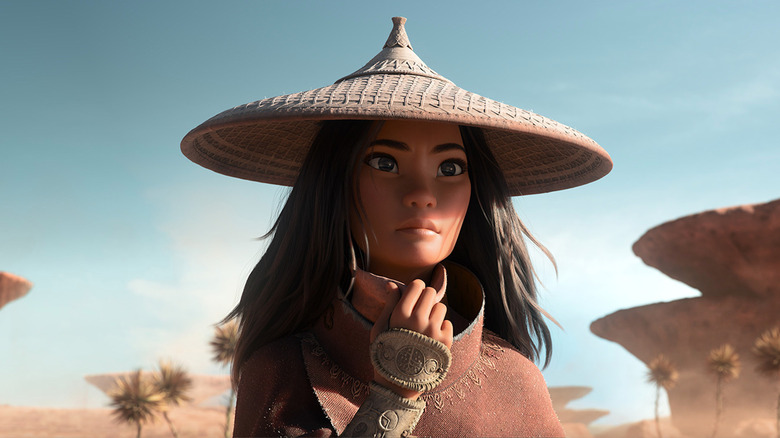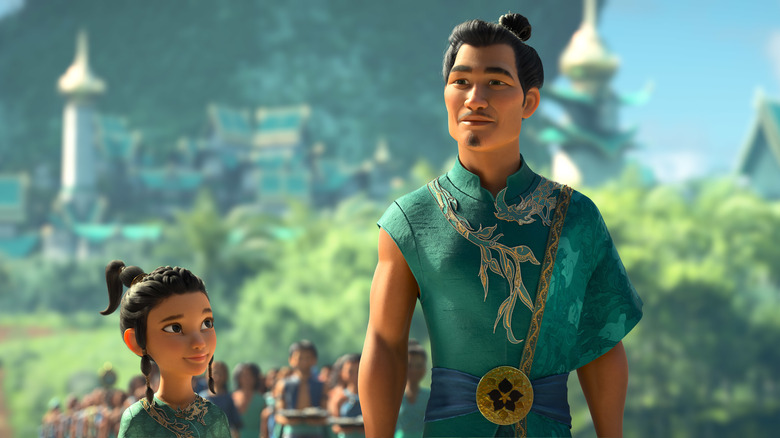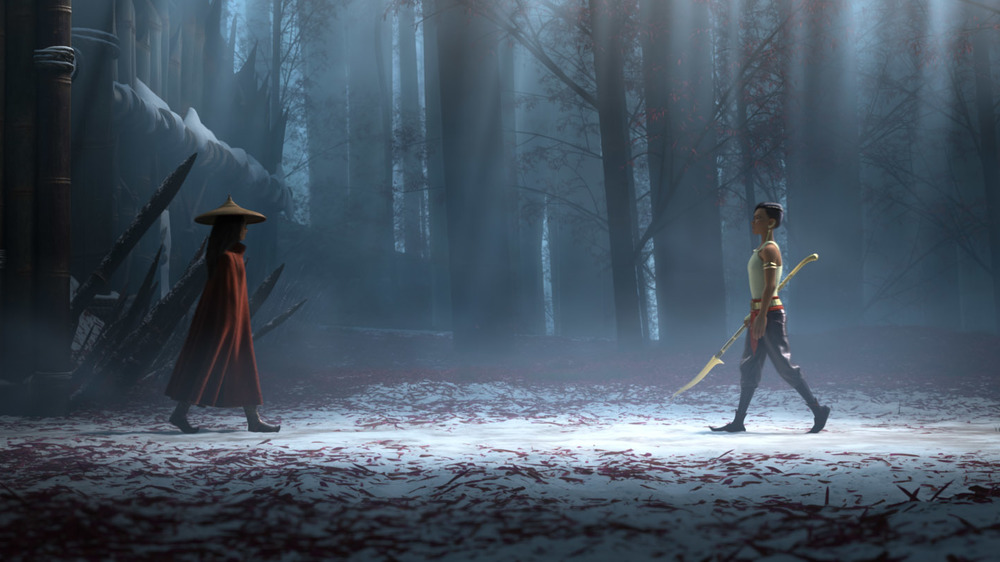Raya And The Last Dragon Review: Straight Fire
Despite trafficking in some well-worn Disney cliches that risk encroaching tedium, Raya and the Last Dragon is a triumph. The film is overwhelmingly delightful, imaginative, and well-structured, leading to a breezy family viewing experience that feels like a spiritual sequel to the brilliant Moana (albeit without the music). In the spirit of its subject matter, it's safe to say that this dragon-themed movie is straight fire.
In the first few minutes, we're quickly caught up to speed on the saga of a fantastical far away kingdom known as Kumandra, whose inhabitants were torn apart 500 years ago into warring lands after an epic battle with soulless, blob-like creatures known as the Druun. These monsters (who seem like spiritual cousins to the demons from Princess Mononoke) turn humans to stone, and that's precisely the fate that befalls Raya's dad (I'd have put a spoiler alert there, but come on, this is a Disney film — of course the parent gets taken out), setting the young woman on a hero's journey to find the only remaining dragon from that long-ago battle.
Raya (voiced by Kelly Marie Tran of The Last Jedi) awakens Sisu (Awkwafina of Crazy Rich Asians), a creature regal in appearance, but far from it in personality. The easy dynamic between these two characters is the heart of the movie, as Raya is a confident young warrior determined to reunite the kingdoms, and Sisu is a free spirit who would rather solve problems through shopping and neighborly gifts. From here, the film takes on an almost video game-like structure, as they travel from one level... err, kingdom... to the next, acquiring new friends and pieces of the "Dragon Gem," each of which rewards Sisu with a Mega Man-like new power.
Beyond that key relationship between Raya and Sisu lies a rich variety of supporting characters who all make strong impressions. Which will be your favorite? Tong (Benedict Wong of Doctor Strange) is a massive, Drax-like warrior with a soft side, eager to avenge tragedies that have befallen his family and home kingdom; Bourn (Izaac Wang of Good Boys) is an engaging 10-year-old entrepreneur who runs a boat restaurant and takes it upon himself to keep this motley crew's tummies full; Little Noi is a troublemaking toddler who picks pockets alongside a trio of monkeys; Tuk Tuk is Raya's HeiHei, Silver and Chewbacca rolled into one, an armadillo/pill bug-creature who serves as her primary mode of transportation.
As many wonderful films as Disney has given us over the last several decades, there is a formula. Whether you see that formula as a pitfall to be circumvented or a tradition to be embraced is in the eye of the beholder. But in the description above and other details not discussed, you can already sense a checklist being ticked off: imperiled parent, warrior princess, animal sidekick, elder whose traditional ways create a blindspot for villainy, magical thingamabobs that must be acquired to return Whatever Land to its once proud glory.
Raya has all of the above, but thankfully isn't willing to simply rely on the old formula and let it do the heavy lifting. Awkwafina is an absolute revelation in her role, making a strong case to become this generation's Robin Williams, John Goodman, or Patrick Warburton — actors who crafted strong secondary careers appearing in numerous animated works, reliably injecting strong personality and charm into whatever was asked of them. The structure of the film is fun, with a new revelation (now Sisu can shapeshift! Now she can fly!) after every battle. Then there's the look of the film, which can be utterly captivating (memorable sequences include Sisu swimming underwater and the various characters throwing dragon gems between them like a hot potato), but is perhaps nowhere more impressive than in the look of the human faces.
Every few years, computer animation seems to make some sort of breakthrough, then never looks back — years ago, a lot was written when the look of hair, water, or crowds was finally conquered. Although there hasn't been much hype around it, something definitely seems to have taken a great leap forward around the depiction of the human face in Raya. It's particularly noticeable in her father, Chief Benja (voiced by Daniel Day Kim of Lost). Most noticeably, they seem to be hitting the infinitesimal sweet spot between realism and cartoon — no uncanny valley here. As a result, the characters' range of emotions are wider than ever, allowing animators to really push those human moments to where they need to be. Sisu's human form (which does a great job of replicating Awkwafina's mannerisms) is another standout, as is Humans star Gemma Chan's Namaari (Raya's enemy and the warrior princess of the Fang land) and her mother Virana (voiced by Sandra Oh of Grey's Anatomy).
Through daddy's eyes
Beyond the pixels, there's an equally impressive amount of talent and imagination on display. Although Kumandra often exhibits the same human shortcomings (war, jealousy, betrayal) as our world, its fantastical nature allows for all sorts of whimsy. There are farting bugs who make tiny explosions, traps and treasures to be discovered, and one of the coolest weapons to appear in a movie in some time: Raya's sword, which takes on a rope-like functionality when required (to swing across a chasm, for instance), then snaps back into sword form ready to once again do battle.
Obviously, Kumandra is based on Southeast Asia, opening up its reality to an intoxicating suffusion in the lands, the food, the combat, and much more. The film does a delicate dance between the real and the imagined, with both playing well off each other. Nothing seems too literal, but everything seems grounded to some degree in plausibility, albeit a magical one.
Although Raya and the Last Dragon has several villains in some ways, in others it has none. The Druun seem to be unthinking, inexorable creatures indiscriminately sweeping the land (probably not intentional, but some could read it as a metaphor for our current pandemic); Namaari and Virana have their issues for sure, but are both strong warriors — and as we see in one scene, the children of their Fang land are being schooled to believe their self-serving actions are heroic.
Battling buddies
This brings us to the most potentially problematic shortcoming of the film, something that might leave a bad aftertaste in your mouth once the credits have rolled. Every great Disney film needs a lesson to hang its hat on (from "You've got a friend in me" to "Beauty is found within" to "Always let your conscience be your guide"), and the lesson here is learning to trust others. Great lesson for kids to learn, right?
Maybe not so much. What if you're being asked to trust someone who has betrayed you? What if you're being asked to trust someone who has betrayed you twice? What if a person chose to trust someone with their life who had already betrayed them twice and put them in a situation where they might now die? Would you call that person a saint, or a sucker?
Once again, it's in the eye of the beholder. But without giving anything away, your reaction to the resolution of Raya depends on you respecting a character's tendency to turn the other cheek, then turn it again, then offer it up yet a third time. If you're a parent, this might present a good opportunity to have a discussion about the virtues of trust... and the importance of recognizing when someone is taking advantage of you.
But ultimately, it's a minor head-scratcher in an otherwise overwhelmingly entertaining film. By the end of the movie, you feel like you know these characters inside and out, and you're very likely to have fallen hard for their fantastical, beautiful land where brightly-colored creatures skip through the sky like toddlers playing in puddles. Here's hoping that Disney makes a sequel and we haven't seen the last of this Dragon.
NOTE: Playing prior to Raya and the Last Dragon in theaters is Us Again, a six-minute short film that will be available on Disney+ in June. It's a sweet little story told without a single word, as an elderly couple rediscover their spark via a magical rainstorm that brings back the dance moves that marked their youth. It's everything a pre-movie Disney short should be: engaging, original, and fun — the cinematic equivalent of an amuse bouche, meant to delight the senses and whet your appetite for the fine meal to come.


